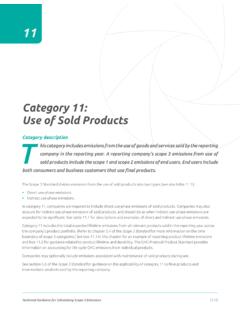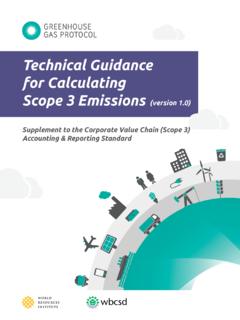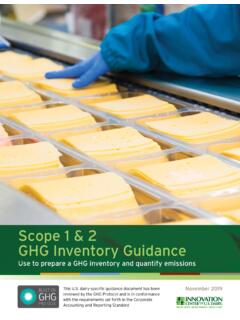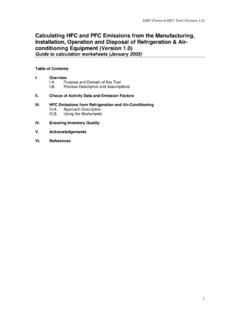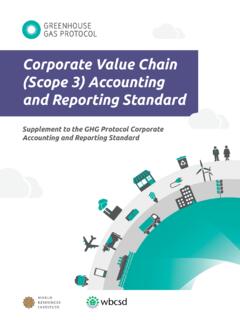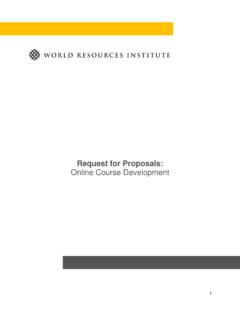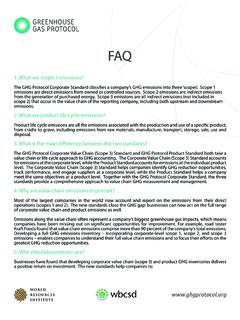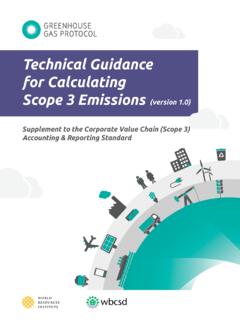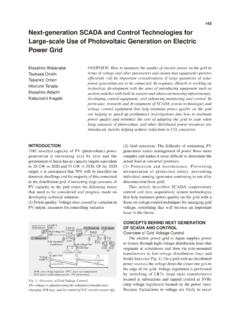Transcription of - Protocol - - for the quantification - - of …
1 Version 2013- Protocol - - for the quantification -- of greenhouse - - gas emissions - - from waste management -- activities - Protocol for the quantification of greenhouse gas emissions from waste management activities Version 2013- Acknowledgments and Contact -This Protocol was developed by the Entreprises pour l Environnement Working Group composed of the following companies:Seche Environnement Suez Environnement Veolia Environnement2 Version 2013 This is the fifth version of the Protocol . It takes into account modifications identified by the EpE Working Group as well as changes related to comments provided by the World Resource Institute (WRI), following their review.
2 The EpE Working Group would like to thank the following associations and agencies for reviewing and commenting on this latest version: The International Solid waste Association (ISWA) - Working Group on waste management and Climate Change the French Federation of waste management Services (FNADE), the Confederation of European waste to Energy Plants (CEWEP), the Dutch waste management Association (DWMA), and the French Interprofessional Technical Centre for Studies on Air Pollution (CITEPA). We also thank the following associations for their continued support of the Protocol : the International Solid waste Association (ISWA), the European Federation of waste management and Environmental Service (FEAD), the French Federation of waste management Services (FNADE), the Environmental Services Association (ESA) in the United Kingdom, the Spanish Association of Hazardous waste Managers (ASEGRE), the Dutch waste management Association (DWMA) and the Confederation of European waste to Energy Plants (CEWEP).
3 EpE gives very special thanks to Alexandra LALET (Suez Environnement SITA) and Flora BERG (Veolia Propret ) for their intensive work on updating this rue de la Chauss e d AntinParis 75009 Tel: +(33). : +(33). : is the French partner of the World Business Council for Sustainable Development (WBCSD). The WBCSD is a CEO-led, global association of some 200 companies dealing exclusively with business and sustainable for the quantification of greenhouse gas emissions from waste management activities Protocol for the quantification of greenhouse gas emissions from waste management activities Version 2013 Acknowledgments and Contact -> 02 Foreword -> 06 Protocol s Objectives and Principles pages 09 to Objectives -> Principles -> Definitions -> 12 waste management Sector pages 13 to waste ManagementActivities -> Specificities of waste Sector sGhG emissions -> 16
4 Inventory Boundaries pages 19 to Organizational boundaries -> Operational boundaries -> Exclusions -> Adjustments -> 281 emissions calculations pages 30 to Reporting Period and data-> Methodologies used -> Calculation Tool -> Global Warming Potentials -> Avoided emissions Calculation -> Specific case of landfill diffuseemissions modelling -> Other specific cases -> Base Year and HistoricEmissions Recalculations -> 40- Table of contents -2344 Version 2013 Managing Uncertainty pages 41 to Uncertainty in GHG emissionsinventories -> Uncertainty calculation -> Reducing uncertainty -> 46 Guidelines for GHG Reporting Presentation pages 47 to Content of the GHG inventoryreport -> Use of ratio indicators -> 50567 Verification pages 51 to 52 Annex 1: Comparative analysis of the greenhouse gases models for landfills -> 55 Annex 2: Carbon Sequestration in Landfills and Soils after compost spreading -> 67 Annex 3.
5 Composting N2O and CH4 emissions Factors -> 765 Protocol for the quantification of greenhouse gas emissions from waste management activities Protocol for the quantification of greenhouse gas emissions from waste management activities Version 2013- Foreword -Six years have passed since the waste Sector Protocol was published for the first time in 2006. Today, global warming and climate change remain amongst the most significant environmental issues facing our planet. In 2006, the Kyoto Protocol had just been ratified and the European emissions Trading Scheme (EU-ETS) had been recently launched, giving strong signals of the world s willingness to create the appropriate structures that would contribute to reducing the global greenhouse gases (GHG) , the current global overview is much less optimistic.
6 The last Conferences of the Parties (COP) and Earth Summit conferences have not delivered clear and ambitious targets and incentives to scale-up the implementation of low-carbon solutions to limit global temperature rise to 2 degrees centigrade. GHG emissions on a global level are far from decreasing or even stabilising. Total GHG emissions for 2010 and then for 2011 have been respectively identified as the highest the uncertainty of the on-going international climate negotiations, many governments have taken steps to reduce GHG emissions through policy measures that include the introduction of emission trading schemes, voluntary programmes, carbon or energy taxes, and regulations on GHG monitoring and reporting.
7 There are increasing demands or expectations for businesses and communities to report their greenhouse gas emissions on a regular basis. 6 Version 2013 Sectorial protocols such as this waste Sector Protocol are therefore very useful in such cases and contribute to the elaboration of complete GHG emissions accounting and reporting Protocol itself has evolved with time, going through 4 version updates. The different versions correspond to evolutions initiated by the original Working Group but also to the suggestions and feedback provided by several waste associations that have reviewed and commented on the Protocol .
8 As a result, several worldwide associations have validated and used the Protocol for their own greenhouse gas inventories. Through these evolutions, the Protocol has been supported by the International Solid waste Association (ISWA), the European Federation of waste management and Environmental Service (FEAD), the French Federation of waste management Services (FNADE), the Environmental Services Association (ESA) in the UK, the Confederation of European waste to Energy Plants (CEWEP), the Dutch waste management Association (DWMA), and the Spanish Association of Hazardous waste Managers (ASEGRE).
9 It is the intent of the EpE Working Group to continue to promote its use internationally. -> Built on the GHG Protocol label In the perspective of continuous improvement of this document, and in order to meet the general expectations of users, the Working Group has decided to initiate a new revision of the Protocol . Unlike the previous versions, it is not only based on a peer review but on a review conducted by the World Resources Institute (WRI). The objective is to have version 5 labelled built on the GHG Protocol . This new label was initiated jointly by the WRI and the World Business Council on Sustainable Development (WBCSD).
10 It is a way for the GHG Protocol to recognize those sector guidance documents, product rules, and calculation tools that have been developed in conformance with the GHG Protocol Corporate Standard. With such label, users should feel confident that the document or tool they are using is in conformance with the GHG Protocol Standards. To obtain the label, the Protocol has been revised and two significant topics have been included. First, the emissions of biogenic CO were added to the calculation tool. Even though these emissions are not included within the scope of direct and indirect emissions , they have to be calculated and reported separately in the tool.
